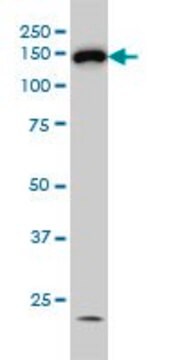OP43
Anty-p53 (Ab-6) (Pantropic) mysie mAb (DO-1)
liquid, clone DO-1, Calbiochem®
Synonim(y):
Mysz anty-p53, Przeciwciało anty-p53, Przeciwciało wykrywające p53
About This Item
Polecane produkty
pochodzenie biologiczne
mouse
Poziom jakości
forma przeciwciała
purified antibody
rodzaj przeciwciała
primary antibodies
klon
DO-1, monoclonal
Formularz
liquid
zawiera
≤0.1% sodium azide as preservative
reaktywność gatunkowa
feline, human
spodziewany brak reakcji z
mouse, rat
producent / nazwa handlowa
Calbiochem®
warunki przechowywania
do not freeze
izotyp
IgG2a
Warunki transportu
wet ice
temp. przechowywania
2-8°C
docelowa modyfikacja potranslacyjna
unmodified
informacje o genach
human ... TP53(7157)
Opis ogólny
Immunogen
Zastosowanie

Mrożone skrawki (1 g/ml; patrz referencje do aplikacji)
Immunoblotting (0.1-1 g/ml; patrz odniesienia do aplikacji)
Immunocytochemia (1-2,5 g/ml; patrz odniesienia do aplikacji)
Immunoprecypitacja (1 g/ml lub użyć nr kat. OP43A; patrz odniesienia do aplikacji)
Skrawki parafinowe (1 g/ml, wymagana pepsyna, obróbka wstępna w suszarce termicznej lub ciśnieniowej; patrz odniesienia do aplikacji)
Opakowanie
Ostrzeżenie
Postać fizyczna
Komentarz do analizy
Komórki SK-OV-3 lub normalna tkanka skóry
Komórki A431 lub tkanka raka piersi
Inne uwagi
Greenblatt, M.S., et al. 1994. Cancer Res.54, 4855.
Legros, Y., et al. 1994. Oncogene9, 2071.
Barak, Y., et al. 1993. EMBO J.12, 461.
Kastan, M.B., et al. 1992. Cell71, 587.
Kuerbitz, S.J. 1992. Proc. Natl. Acad. Sci. USA89, 7491.
Lane, D.P. 1992. Nature358, 15.
Vojtesek, B., et al. 1992. J. Immunol. Meth.151, 237.
Kastan, M.B., et al. 1991 Cancer Res.51, 6304.
Informacje prawne
Nie możesz znaleźć właściwego produktu?
Wypróbuj nasz Narzędzie selektora produktów.
Kod klasy składowania
10 - Combustible liquids
Klasa zagrożenia wodnego (WGK)
nwg
Temperatura zapłonu (°F)
Not applicable
Temperatura zapłonu (°C)
Not applicable
Certyfikaty analizy (CoA)
Poszukaj Certyfikaty analizy (CoA), wpisując numer partii/serii produktów. Numery serii i partii można znaleźć na etykiecie produktu po słowach „seria” lub „partia”.
Masz już ten produkt?
Dokumenty związane z niedawno zakupionymi produktami zostały zamieszczone w Bibliotece dokumentów.
Nasz zespół naukowców ma doświadczenie we wszystkich obszarach badań, w tym w naukach przyrodniczych, materiałoznawstwie, syntezie chemicznej, chromatografii, analityce i wielu innych dziedzinach.
Skontaktuj się z zespołem ds. pomocy technicznej








